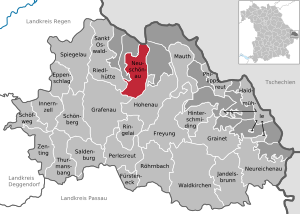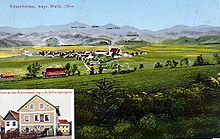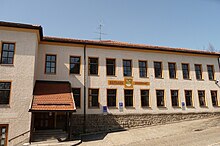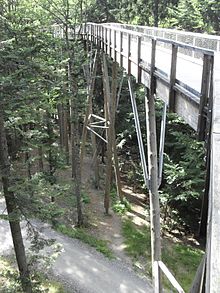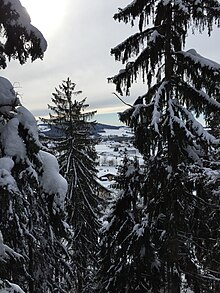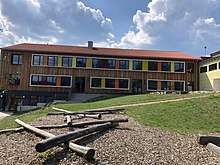Neuschönau
| coat of arms | Germany map | |
|---|---|---|

|
Coordinates: 48 ° 53 ' N , 13 ° 29' E |
|
| Basic data | ||
| State : | Bavaria | |
| Administrative region : | Lower Bavaria | |
| County : | Freyung-Grafenau | |
| Height : | 752 m above sea level NHN | |
| Area : | 27.53 km 2 | |
| Residents: | 2199 (Dec. 31, 2019) | |
| Population density : | 80 inhabitants per km 2 | |
| Postal code : | 94556 | |
| Primaries : | 08558, 08552 , 08553 | |
| License plate : | FRG, GRA, WOS | |
| Community key : | 09 2 72 146 | |
| Community structure: | 7 districts | |
| Address of the municipal administration: |
Kaiserstraße 13 94556 Neuschönau |
|
| Website : | ||
| Mayor : | Alfons Schinabeck ( CSU ) | |
| Location of the municipality of Neuschönau in the Freyung-Grafenau district | ||
Neuschönau is a municipality (until 1981 Schönanger municipality ) and a parish village in the Lower Bavarian district of Freyung-Grafenau . Neuschönau is a state-approved resort .
geography
Geographical location
The municipality is located in the Danube Forest region in the Bavarian Forest . It borders in the east on the municipality of Hohenau , in the west on the municipality of Sankt Oswald-Riedlhütte , in the south on the city of Grafenau (Lower Bavaria) and in the north on the Czech municipality Modrava (Mader). The municipality boundary is partly formed by the Kleine Ohe in the west and the Sagwasser in the south and east. Over ⅔ of the community are in the Bavarian Forest National Park .
Community structure
There are seven districts:
- Altschönau
- Forest forest
- Grünbach
- Katzberg
- Neuschönau
- Schönanger
- Forest houses
The Lusen is 1373 above sea level, the highest elevation in the community.
history
Schönau (today's "Altschönau") is mentioned for the first time in 1395 as Schönaw , when the Counts von Hals had eight farmers' fiefs laid out. In 1417 the oldest glassworks in the Grafenau district was built there. Over the centuries the village of Schönau became "Altschönau" and the village of Neukaiserhütte became "Neuschönau".
The district Waldhäuser had been on Gulden Stras , the Bavarian rival route to the Goldener Steig, on which salt was transported from the Danube ports to the Czech Republic , since the 15th century . This is symbolized in the coat of arms with a golden path from top left to bottom right.
It remained an important glassmaking place until the 19th century, symbolized in the coat of arms with a glass in the upper right corner. The Kaiserhütte (Neuhütte) came into the ownership of the Hilz family in the 18th century. Hilz's son-in-law Philipp Wieninger (1767–1835), who had already acquired a brewery in Teisendorf in 1813 , sold it to Kaspar Hafenbrädl in 1823.
On October 7, 1970, the Bavarian Forest National Park was the first German national park to be established. With the Hans Eisenmann House and the adjoining animal open area, Neuschönau became the gateway to the national park .
Church building
The community Schönanger caused by the Bavarian Gemeindeedikt was founded in 1818, also included Neuschönau and the places Altschönau , Forstwald, Green Brook, Katz mountain and forest homes. In 1978, in the course of the municipal reform of Sankt Oswald and Schönanger, it was merged into an administrative community. This was dissolved again in 1980 after protests in both communities.
After a vote, the municipality name was officially changed from Schönanger to Neuschönau on June 1, 1981 .
Neuschönau has had its own fire brigade since 1887.
Population development
Between 1988 and 2018 the population stagnated or increased minimally from 2,216 to 2,231 by 15 inhabitants or 0.7%. On December 31, 1999 the community had 2,423 inhabitants.
politics
mayor
The professional first mayor is Alfons Schinabeck (CSU). He has been in office since May 1, 2014 and was re-elected with 91.3% in the March 15, 2020 election.
- 2nd Mayor Michael Segl (CSU)
- 3. Mayor Otto Biebl (FW)
Municipal council
- CSU: 9 seats
- FWG: 5 seats
coat of arms
The local council decided on June 1st, 1981 to give the community a coat of arms. The design by Hans Rosenthaler prevailed. It was awarded to the completion of the town hall renovation.
The description of the coat of arms reads: A golden sloping bar above a silver tin shield base in green, a silver wine glass on the left.
The golden sloping beam is supposed to symbolize the Gulden street leading through forest houses . The wine glass stands for the glassmaking tradition. The green background indicates the extensive forests. These were prerequisites for the operation of the glassworks, which have been demonstrable since the 15th century. The glass in the coat of arms reminds of this once so important branch of industry; the last glassworks were shut down in the 19th century. The golden sloping bar symbolizes the so-called Sammersteig (Guldenstras or Guldensteig), which was necessary for the salt trade with Bohemia.
The crenellated shield is reminiscent of the traditions of a castle in the Schönanger district that was destroyed in the Middle Ages (robber baron Wilhelm von Schönanger). In this context, the district administrator Paul Praxl finally proved that, despite the relevant traditions and information, Wilhelm von Schönanger, executed in 1247 on the orders of the Bavarian Duke, and Anger Castle, which was later razed at the urging of the Passau bishop , had nothing to do with Schönanger (Neuschönau) , but are to be assigned to the Schönanger near Rinchnach. This design with the castle battlements was nevertheless implemented.
religion
93% of the population of the community is Roman Catholic, 3% Protestant and 4% non-religious or non-denominational.
The year 1896 was the year the Neuschönau branch was established . The neo-Gothic Expositur and later parish church of St. Anna was built from 1895 to 1903 according to plans by the architect Johann Baptist Schott . It has a neo-Gothic high altar as well as baroque pictures and figures.
In 1917 Neuschönau became an independent parish that was separate from St. Oswald ( St. Oswald Monastery ) , with the exception of the Waldhäuser district.
The parish was founded on August 22, 1917; the first pastor was Expositus Georg Kaiser. In 1926, two large fires raged in Neuschönau. In 1929 the church tower and roof were badly damaged by a large storm. In 1981 a fire broke out in the sacristy.
After the major renovation in 2001, the congregation proudly celebrated the 100th birthday of their church in 2008. The Catholic parish of Neuschönau is now part of the Deanery Freyung-Grafenau and, together with the parishes of Grafenau and Sankt Oswald, forms the Grafenau parish association.
There are also village chapels in the districts:
- Altschönau (Br. Konrad)
- Schönanger ( St. Josef Chapel )
- Waldhäuser (St. Maria im Wald), looked after by the parish of Grafenau
- Weidhütte (Assumption of Mary)
- Grünbach (St. John the Baptist)
- Forstwald (Sorrowful Mother of God)
The chapel in Schönanger is the oldest church building in the community (1847). The chapel is adorned by two old linden trees, which are around 160 years old and are a protected natural monument.
The parish is part of the dean's office Freyung-Grafenau (until 2010 dean's office Grafenau) and the diocese of Passau .
There are no other institutions of other denominations and religions in the community apart from the above-mentioned catholic houses of worship. The nearest Protestant churches can be found in the neighboring parishes.
Facilities
- Heinz Theuerjahr elementary school
- Due to the falling number of pupils, the primary school was closed in the 2006/07 school year and converted into a primary school. Since then, the secondary school students have attended the secondary school in Riedlhütte, which in return sends some of its primary school students to Neuschönau.
- Parish kindergarten Neuschönau
- The municipality of Neuschönau is involved in the golf course in the Bavarian Forest National Park in Haslach. This is directly adjacent to the municipality.
- In Waldhäuser there is a youth hostel and the sculpture park Arche Heinz Theuerjahr .
- Solar park in the Schönanger industrial park
- Lusen National Park Information Center with Hans-Eisenmann-Haus, animal open-air area, plant and stone open-air area and the treetop path in the Bavarian Forest National Park . Venue of the NaturVision film festival.
Regular events
- January 5th: Lousnacht - procession of the Raunacht spirits
- May: setting up the maypole
- June / July: NaturVision film festival
- August: Children's Bear Festival
- October / November: Lusentheater - amateur theater group
- December: Christmas market in the village and on the treetop path
Architectural and ground monuments
traffic
Road traffic
The community is only accessible through district and municipal roads. These connect them with the neighboring communities.
The federal highway 533 Grafenau – Freyung runs south of the municipality . This leads into the federal highway 85 near Grafenau and the federal highway 12 near Freyung.
Public transport
Neuschönau is connected to the public transport network of the Bavarian Forest through the Igelbus system and the RBO's regular buses . The summer hedgehog buses run from May to October, the winter hedgehog bus, newly created in 2010, runs from the end of December (Christmas holidays) to May. As a partner community, the RBO bus R-JN 747 was christened Neuschönau .
The Bayerwald-Ticket is valid in the municipality of Neuschönau . Since May 1, 2010, the municipality, along with other Bavarian forest communities, has been involved in the GUTi Guest Service Environment Ticket , which offers its guests free transport on all rail and bus connections in the Bayerwald Ticket tariff area.
Rail transport
The Zwiesel – Grafenau railway line runs about six to ten kilometers from the town center. The community is connected by buses to the Grafenau and Spiegelau train stations. The closest stop in Rosenau (near Grafenau) can only be reached by long footpaths.
The Passau – Freyung railway line , which is operated in leisure traffic on the weekend between May and October, is also connected to the community by connecting buses.
Hiking trails
After the Czech Republic there has been a border crossing for hikers since July 15, 2009. This is located on the small Spitzberg not far from the historic Blue Columns border crossing. For environmental reasons, it is only open from July 15th to November 15th. The entire community is well developed through hiking trails. In winter, an extensive network of cross-country trails stretches across the municipality.
tourism
On January 1st, 2009 the Interreg funded “Wild Animal” project, a cooperation between nature conservation and tourism, started. 13 Bavarian and nine Bohemian municipalities as well as the Bavarian Forest and Sumava National Parks have come together in order to optimally use and combine the strengths of the national park region. The bear is the sponsor of the community.
The point of attraction for hikers is the Lusengipfel (1373 m) with its huge dome made of granite boulders, which represent a geological peculiarity. Tradition and customs are still upheld, as is the local cuisine in the restaurants.
Since September 2009, Neuschönau has been home to the treetop path in the Bavarian Forest National Park, the longest treetop path in the world with its impressive tree tower. With a total length of 1.3 km, it leads visitors through the treetops to the viewing platform of the 44 m high tree tower.
The cross-community "National Park Card" has been in effect since December 15, 2010. In addition to the free use of the Igelbus and forest railway, this gives guests a number of other attractive discounts and free services: Reduced entry to the treetop path, reduced entry to the region's baths, reduced entry to museums and much more.
Personalities
- Erhard Kutschenreuter was a teacher in Neuschönau from 1902 to 1904 and composed the Waldlermarsch in 1904 . The area forester Max Mang, who also works in Neuschönau, wrote the text.
- Heinz Theuerjahr , sculptor, lived from 1939 until his death in 1991 in the artist village of Waldhäuser, an honorary citizen of the Neuschönau community
- Herbert Muckenschnabl , painter and graphic artist
- Johann Bosser, priest and clergyman, honorary citizen (1889–1970)
- Heinrich Erhart, dean emeritus and clergyman, honorary citizen
literature
- Heidi Schopf: Unterm Lusen - Local history reader about the community of Neuschönau . Rosenthaler Druck, 1994
Web links
- Internet presence of the place
- Entry on the coat of arms of Neuschönau in the database of the House of Bavarian History
Individual evidence
- ↑ "Data 2" sheet, Statistical Report A1200C 202041 Population of the municipalities, districts and administrative districts 1st quarter 2020 (population based on the 2011 census) ( help ).
- ↑ a b Mayor / Lord Mayor in municipalities belonging to the district (as of May 1st, 2020). (xlsx) Bavarian State Office for Statistics, accessed on June 12, 2020 .
- ^ Community Neuschönau in the local database of the Bavarian State Library Online . Bavarian State Library
- ^ Federal Statistical Office (ed.): Historical municipality directory for the Federal Republic of Germany. Name, border and key number changes in municipalities, counties and administrative districts from May 27, 1970 to December 31, 1982 . W. Kohlhammer GmbH, Stuttgart / Mainz 1983, ISBN 3-17-003263-1 , p. 628 .
- ↑ 61 clubs congratulated their 125th birthday , Grafenauer Anzeiger, June 25, 2012, accessed on June 26, 2012

